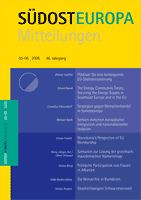Die Monarchie in Rumänien – Zur europäischen Einordnung einer südosteuropäischen Institution
The Monarchy in Romania – Positioning of a Southeast European Institution in a European Context
Author(s): Edda Binder-IijimaSubject(s): History
Published by: Südosteuropa Gesellschaft e.V.
Summary/Abstract: The European unification process, symbolized by the motto of the European Union „United in Diversity“, and the claim for forging a common destiny for the European peoples, while remaining proud of their own national identities and history, as stated in the preamble of the Treaty for a Constitution for Europe, means also a challenge for European historiography. Moreover, it leads to the question to what degree a country’s history is shaped by indigenous factors and mainstream European influences. A look into the development of the Romanian monarchy may exemplify how the old traditional institution of “The Prince” was transformed into a constitutional monarchy under the influence of the overall European constitutional process in the 19th century. All newly established countries in South Eastern Europe were confronted with the simultaneous problems of state- and nation-building. To secure internal and external stability, the elites of Romania, Greece and Bulgaria adopted the model of a constitutional monarchy under a foreign ruler, also as a means to integrate themselves in a monarchical European community and to be treated on equal terms, a process with parallels to the present situation in Europe. The article discusses problems how in the case of Romania, the kings of a foreign dynasty – the Hohenzollern-Sigmaringen – contributed to the formation of a political system with a strong government impact and how nowadays, the royal legacy influences Romanian historiography and politics.
Journal: Südosteuropa Mitteilungen
- Issue Year: 2006
- Issue No: 05-06
- Page Range: 78-91
- Page Count: 14
- Language: German
- Content File-PDF

